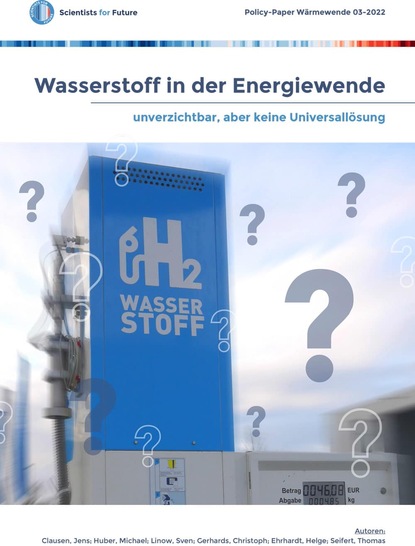According to concerted opinion, hydrogen is now considered the new universal energy carrier that is set to take the place of fossil energy sources in gas heating systems, cogeneration plants, cars, steel works and the chemicals industry. This is also recognized by Scientists for Future. In a recently published policy paper they describe hydrogen’s essential place in the energy transition yet also point out that its use is inadvisable in many areas on technical, economic and environmental grounds. The key sections of this paper are set out here:
In principle, hydrogen can be transported in the same way as natural gas via pipelines or tanker vessels and stored in tanks or caverns. This suggests that green hydrogen, in other words decarbonized hydrogen that is produced electrolytically with renewable power, could act as a replacement in all situations where we currently use fossil-based raw materials such as crude oil and – above all – natural gas. This belief is deceptive since for many purposes the deployment of green hydrogen is much too expensive and is an inefficient use of energy. Ultimately we will only use green hydrogen in cases where natural gas and crude oil cannot be replaced by the direct application of electricity or where hydrogen is the base material, for instance in the chemicals industry or in the carbon-free manufacturing of steel.
A calculated optimism is clearly evident in some studies by natural gas network operators: The German gas and water industries association DVGW, whose membership includes over 2,000 utility companies, does not work on the basis that there will be a shortage of hydrogen. A study published by the DVGW calculates that high demand will be accompanied by an equally high degree of availability of more or less sustainable hydrogen (Gatzen & Reger, 2022). Underpinning this is the unsupported assumption that there will be an import rate of 90 percent, in other words the same level as today’s oil and gas imports.
“Just supplanting one fuel with another will not suffice for the energy transition. The energy transition inevitably requires a shift away from traditional technologies and habits.”
These optimistic assumptions on the availability primarily of imports are at the center of the argument that hydrogen would be available even for heat provision: “In contrast to the frequent assumption, hydrogen does not have to remain a scarce good. The demand for hydrogen can be more than covered from 2030 onward. The quantity exceeds all current demand forecasts many times over” (DVGW, 2022, p. 5). This strikingly optimistic supposition can be confirmed neither technically nor scientifically.
At least 10 years will pass before larger quantities can be imported. And what often goes unsaid in relation to desired hydrogen imports is that the transportation is so expensive that imported hydrogen will cost many times more than today’s natural gas or crude oil. On this point it makes no difference whether the hydrogen is transported in a compressed, liquefied or chemically bonded form.
The use of hydrogen is only wise if it is produced with renewable electricity (green hydrogen). In future this will also be the cheapest production method. Hydrogen manufactured from natural gas (gray or blue hydrogen) and hydrogen from methane pyrolysis (turquoise) are not carbon neutral due to the use of natural gas and the upstream emissions from methane; and excessive risks and long-term consequences are associated with the use of nuclear energy for electrolysis as an ecofriendly method of producing hydrogen (pink).
Analysis of individual application areas
The need to use hydrogen is already on the horizon in certain sectors. This affects, for example, iron and steel production as well as the chemical raw materials industry and hydrogen as an energy storage medium. At present, refineries require hydrogen for several processes, including the cracking of crude oil when manufacturing fossil fuels. This area of current hydrogen demand will disappear in the future. In other applications, hydrogen competes with other good solutions:
In vehicles, e.g., automobiles, electric propulsion is the most efficient and most practical solution. It is for this reason that manufacturers have practically given up on hydrogen propulsion for the future (Clausen, 2022). The situation for delivery vehicles, city buses and railroads can be said to be similar. Even when it comes to long-distance trucks, the Fraunhofer Institute for Systems and Innovation Research points out that, should the first hydrogen trucks be available in 2027, the second generation of battery-electric trucks will already be on the road (Plötz, 2022). The window of opportunity for successfully launching fuel cell trucks onto the market would therefore be essentially closed and all that would be left for hydrogen trucks would be a small niche, namely the transportation of heavy loads to very remote locations (Plötz, 2022).
The situation for local trains is comparable. Due to the progress in battery technology, the deployment of hydrogen trains would only be advisable as a bridging solution for very long routes without recharging facilities until such time that the lines are electrified or long-range battery-powered trains become available (VDE (ed.) 2019, Soller, 2020).
The position is similar for the production of heat and hot water. Numerous studies by scientific institutions characterize the use of hydrogen for heating as expensive and inefficient compared with electric heat pumps (for an overview see Clausen, 2022).
Shipping is faced with the problem of how to store large quantities of energy for long nonstop journeys. This is where liquefied hydrogen could be the most efficient solution. Synthetic (power-to-liquid) fuels that are manufactured from green hydrogen are generally less efficient as one or more conversion processes are needed for its production. Ammonia, for example, comes into discussion in this context because it is can be stored far more easily than hydrogen. The advantages of liquid fuels in deep-sea shipping are so considerable that other propulsion systems are difficult to imagine. Investigations are also already underway on ammonia-fed fuel cells in ships (Fraunhofer IMM, 2021). However this is less energy efficient in comparison with liquid hydrogen.
One special case is the “dream of carbon-neutral flying” (Bottler, 2021), as promised by the aviation sector with reference to sustainable aviation fuel, or SAF, from hydrogen. At present, SAF, which may also be bio-based, is the most widely known feasible alternative to fossil kerosene for long-haul flights. Yet even the use of SAF has only a minor impact on climate change, equivalent to around 33 percent of the greenhouse gas effect (cf. chapter 4). As such, there is almost no other option than to radically limit air travel, electrify it or endure a lengthy wait for new inventions.
Curbing unrealistic expectations
As it stands, the future deployment of hydrogen is being organized at a much quicker pace than its production. Consequently, the rapid adoption of hydrogen and its intensive use for a variety of purposes risk smoothing a rather direct path toward supply insecurity, a scramble for resources, cannibalism between applications and high prices. One effect would be that damaging fossil fuels would be needed for longer than necessary.
A further risk is that decision-makers and the general public, either through a lack of information or due to wishful thinking, will assume that using hydrogen as an energy carrier will enable the costs of many things to stay the same, for instance in the case of car travel with synthetic gasoline and gas heating with hydrogen in the gas network (which would need to be converted at great expense). This could lead to us introducing a costly and inefficient technology, purely because it seems simple and familiar. We would be committing ourselves to an expensive energy system instead of switching directly to a predominantly electrified system that is better value and more flexible (Zachmann et al., 2022).
Since the production and supply of hydrogen is associated with high energy losses of at least a third of the green electricity used as the primary energy source, we will need much higher volumes of green power to create a “hydrogen world,” i.e., many more wind turbines, photovoltaic plants and others. But already there is a lack of clarity surrounding where all these plants will be located, who will build them and which type of material will be used.
Even if the efficiency of electrolysis can be increased by several percentage points, hydrogen would still be an inefficient and expensive solution in all situations where electric alternatives exist.
Example
In Europe, if we do not electrify industrial process heat, which would use 900 terawatt-hours a year of power (Madeddu et al., 2020), and instead produce and combust hydrogen for heating purposes, then approx. 1,350 terawatt-hours a year of green electricity would be needed for its production. This approach uses approx. 450 terawatt-hours more than the radical electrification route and is roughly equivalent in energy terms to the present-day electricity consumption of Great Britain. Accepting this additional energy consumption solely in order to perpetuate previous practices and behavior makes no sense from an economic or energy standpoint.
Conclusion
Policymakers must not promote hydrogen technologies without proper scrutiny. They should clearly analyze the fields of application and identify the areas where hydrogen represents a good solution and the areas where there are better, more efficient technologies that are less expensive in the long run. By focusing unambiguously on the promotion of electric transportation and heat pumps, the German political establishment shows it is engaged in implementing this key finding.
Reference(s)
J. Clausen et al. (2022): “Wasserstoff ist unverzichtbar, aber keine Universallösung für die Energiewende,” Scientists for Future policy paper. https://info-de.scientists4future.org/wasserstoff-in-der-energiewende/
Authors: Scientists for Future




